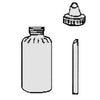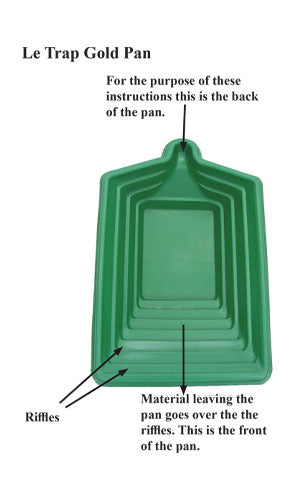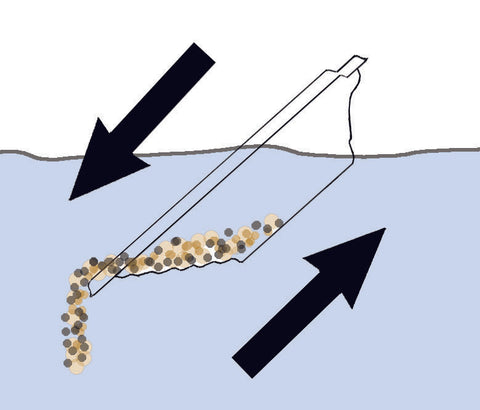Learning to pan for gold is a process that is easy to learn and can be very rewarding, physically because it is good exercise, and financially because gold is a valuable commodity.
What is a gold pan? A gold pan is a machine operated by hand that separates gold and other valuables from sand and gravel. How does a gold pan separate gold and other valuables from sand and gravel? Gold, diamonds, and other gemstones have a specific gravity that is greater than the normal specific gravity of the sand and gravel where it is located. Specific gravity is a measure of the density of a material. Water is used as the baseline and is set at 1. Anything that is more dense than water will have a specific gravity larger than 1. The average specific gravity of diamonds is about 4. Diamonds are 4 times as dense as water. The specific gravity of lead is about 11, and the specific gravity of gold is 19. Gold is very dense, almost twice as dense as lead and 19 times as dense as water. When gravel containing pieces of gold is placed in water the gold will find its way to the bottom quickly. A gold pan is designed so that sand and gravel can be covered with water and agitated, so that the gold sinks to the bottom. Then the pan is tipped slightly so that some of the lighter material on top is washed away, and the process of agitation and dipping is repeated until there is so little material left that the gold can be seen and recovered.
When you can see the gold how do you recover it? Depends on the size of the pieces. Pieces that are large enough to pick up with your fingers are called “pickers”. Pieces that are not quite big enough to be a picker can be recovered with a pair of tweezers. Anything that is too small for tweezers requires a suction tweezer, like an eyedropper, or a snuffer bottle.

Gold has served as the most important monetary standard throughout history. It is measured in troy ounces and the price of gold is typically stated in terms of the cost of one Troy ounce. Historically, the United States has fixed the price of gold. The price of an ounce of gold was fixed at about $20.00 from 1786 until 1934, at which point the price was raised to $35.00. In 1968 a two-tiered pricing structure was established, and by 1975 the price of gold was allowed to fluctuate like any other commodity. On January 21st, 1980 the price of gold reached its peak of $850, and by the year 2000 the price dropped to $272.
Gold Average Price of One Troy Ounce Since 2000
| 2000 $279 | 2012 $1667 |
| 2001 $271 | 2013 $1413 |
| 2002 $309 | 2014 $ 1199 |
| 2003 $363 | 2015 $1142 |
| 2004 $409 | 2016 $1252 |
| 2005 $444 | 2017 $1260 |
| 2006 $603 | 2018 $1268 |
| 2007 $685 | 2019 $1393 |
| 2008 $875 | 2020 $1773 |
| 2009 $969 | 2021 $1798 |
| 2010 $1286 | 2022 $1801 |
| 2011 $1662 | 2023 $1940 |
A troy ounce is about 31.1 Grams. At $1900 per ounce one Gram is worth about $60. One gram is the weight of a $1 bill. Five grams is the weight of one Nickle and would be worth $300.
Pennyweight and Grains ???? You will also hear prospectors talking about gold measured in pennyweight and grains. Pennyweight is a standard unit of measurement used in the precious metals industry. It originated as a unit of the troy weight system in 15th Century England and remains the standard for valuing precious metals today. During 15th Century England, the weight of an English penny was exactly 1/20th of a troy ounce of sterling silver. Therefore, there are 20 pennyweights in a troy ounce. This system further divides the pennyweight into grains. There are 24 grains per pennyweight and therefore 480 grains per troy ounce. Many modern digital scales will measure in Troy Ounces, Grams, Pennyweight, or Grains.
Cleaning a New Plastic Gold Pan: New plastic gold pans may have a chemical film on the surface that is a deposit from the injection molding process. This film will act like oil and will cause water to bead up and make the panning process more difficult. This film will wear off in time but to speed the process it is a good idea to wash a new plastic pan with a mild detergent.
What is black sand? The gold you are recovering from the sand and gravel in a creek or river was once locked in a rock vein in a mountain. A few million years later mother nature has turned the mountain into the sand and gravel you are dealing with. The gold that was in the vein is there but so is the rest of the mountain. Part of the rest of the mountain is small pieces of iron mineralization we call black sand.
Is black sand a good thing or a bad thing? Black sand can be a very fine dense sand that is more difficult to pan than most other sands. In that sense it is bad, but it is not all bad because the presence of black sand is an indicator that the material you are panning is highly mineralized. Highly mineralized gravel is more likely to contain gold.
Can black sand be picked up with a magnet? Yes and no. Some types of iron mineralization are very magnetic but others are not. A magnet is an easy way to deal with magnetic black sand but be careful how you use it. Always have the gravel covered with water and hold the magnet above the water so that gold is not inadvertently picked up in a wet clump.
Black Sand Magnets: There are special black sand magnets that lift the magnetic material so that you can remove it from the pan and then easily drop the material off the magnet.
How to hold the Le Trap Gold Pan? The Le Trap Gold Pan has deep riffles to help you keep the gold in the pan. These are ridges in the pan that stop the gold from sliding out of the pan. You always want to hold the pan so that the riffles are directly away from you and the material that is being ejected from the pan has to travel across the riffles.
Le Trap Gold Pan For the purpose of these instructions this is the back of the pan.

How to Use the Le Trap Gold Pan
Follow these simple steps to become an expert gold panner. When you are learning to pan, it is a good idea to pan in a tub so that you can recover the material and do it again.
(1) Place the material in the gold pan and add enough water to cover the gravel.
(2) Hold the pan level and shake the gold pan to settle the gold to the bottom of the pan. It helps to mix the gravel with your fingers.


(3) Dip the gold pan in the water and allow the lighter material to wash out while moving the pan back and forth. Let some of the lighter material wash out of the pan.

(4) Level the pan and shake the pan again as you did in step 2.

Repeat Steps 2 and 3 until there is such a small amount of material in the pan that you can spread it out on the bottom of the pan and see the gold!
Recovering the Gold! Back Panning
When there is a very small amount of material in the pan it will help you see and recover the gold with a process called back panning. Place a small amount of water in the pan and Follow these instructions.

With a small amount of water in the pan tip the pan slightly forward, in the same manner you were panning, so that all of the material left is at the bottom edge near the first riffle. It will help to tap the pan on the front edge with your finger. The material in the pan will move toward the tap.

Gently level the pan and then tip it back slightly so that the small amount of water moves to the back, away from the riffle. Now tilt the pan slightly forward and then back so that each time a small amount of ma- terial moves to the back side. After a few of these cycles back and forth the gold will be visible at the front edge of the pan.


Pick up the gold with the suction tweezer, using them like an eyedropper, and squeeze the gold into the small vial.
Start Over ........
































































